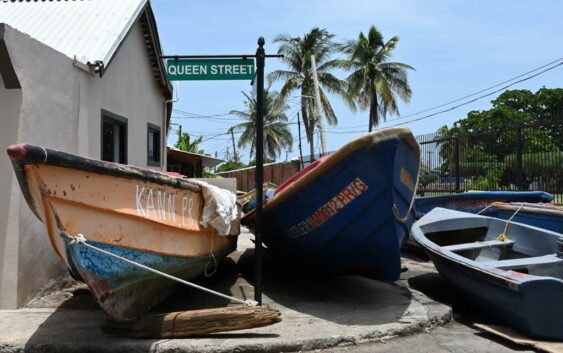- North Buncombe High School students lead recovery efforts for NC farmers post-Hurricane Helene
- LA mayor dismisses fire chief over response to most destructive wildfire in city history last month
- Some in Hurricane Helene-ravaged North Carolina embrace Pres. Trump’s push to abolish FEMA
- Homes destroyed: Western NC families battling insurance disputes after Hurricane Helene
- Freezing weather, wildfire and flood risk forecast across Texas
Hurricane Beryl roars toward Jamaica after killing at least 6 people in the southeast Caribbean

Late Monday, Beryl became the earliest storm to develop into a Category 5 hurricane in the Atlantic and peaked at winds of 165 mph before weakening back to a Cat 4.
KINGSTON, Jamaica — Hurricane Beryl was roaring toward Jamaica on Wednesday, with islanders scrambling to make preparations after the powerful Category 4 storm earlier killed at least six people and caused significant damage in the southeast Caribbean.
In Kingston, people boarded up windows, fishermen pulled their boats out of the water before sitting around a table to play dominoes beside a bay, and workers dismantled roadside advertising boards to protect them from the expected lashing winds to come.
A hurricane warning was in effect for Jamaica, Grand Cayman, Little Cayman and Cayman Brac. Beryl was forecast to weaken slightly over the next day or two, but still be at or near major-hurricane strength when it passes near or over Jamaica on Wednesday, near the Cayman Islands on Thursday and into Mexico’s Yucatan Peninsula on Friday, according to the U.S. National Hurricane Center.
A hurricane watch was in effect for Haiti’s southern coast and the Yucatan’s east coast. Belize issued a tropical storm watch stretching south from its border with Mexico to Belize City.
Late Monday, Beryl became the earliest storm to develop into a Category 5 hurricane in the Atlantic and peaked at winds of 165 mph (270 kph) Tuesday before weakening to a still-destructive Category 4. Early Wednesday, the storm was about 185 miles (300 kilometers) east-southeast of Kingston. It had maximum sustained winds of 145 mph (230 kph) and was moving west-northwest at 20 mph (31 kph), the center said.
Beryl was expected to bring life-threatening winds and storm surge to Jamaica, where officials warned residents in flood-prone areas to prepare for evacuation.
“I am encouraging all Jamaicans to take the hurricane as a serious threat,” Prime Minister Andrew Holness said in a public address Tuesday. “It is, however, not a time to panic.”
In Miami, U.S. National Hurricane Center Director Michael Brennan said Jamaica appears to be in the direct path of Beryl. He urged residents to find a safe place to shelter and stay there through Wednesday.
“We are most concerned about Jamaica, where we are expecting the core of a major hurricane to pass near or over the island,” he said in an online briefing.
Storm surge of 6-9 feet (1.8 to 2.7 meters) above typical tide levels are likely in Jamaica, as well as heavy rainfall.
A tropical storm warning was in place for the entire southern coast of Hispaniola, an island shared by Haiti and the Dominican Republic.
As Beryl barreled through the Caribbean Sea, rescue crews in southeastern islands fanned out to determine the extent of the damage the hurricane inflicted on Carriacou, an island in Grenada.
Three people were reported killed in Grenada and Carriacou and another in St. Vincent and the Grenadines, officials said. Two other deaths were reported in northern Venezuela, where five people are missing, officials said. About 25,000 people in that area also were affected by heavy rainfall from Beryl.
One fatality in Grenada occurred after a tree fell on a house, Kerryne James, the environment minister, told The Associated Press. She said Carriacou and Petit Martinique sustained the greatest damage, with scores of homes and businesses flattened in Carriacou.
Grenada’s prime minister, Dickon Mitchell, said Tuesday there was no power, roads are impassable and the possible rise of the death toll “remains a grim reality.”
St. Vincent and the Grenadines Prime Minister Ralph Gonsalves has promised to rebuild the archipelago. He noted that 90% of homes on Union Island were destroyed, and that “similar levels of devastation” were expected on the islands of Myreau and Canouan.
The last strong hurricane to hit the southeast Caribbean was Hurricane Ivan 20 years ago, which killed dozens of people in Grenada.
Grenada, known as the “spice isle,” is one of the world’s top exporters of nutmeg. Mitchell noted that the bulk of the spices are grown in the northern part of the island, which was hit hardest by Beryl.